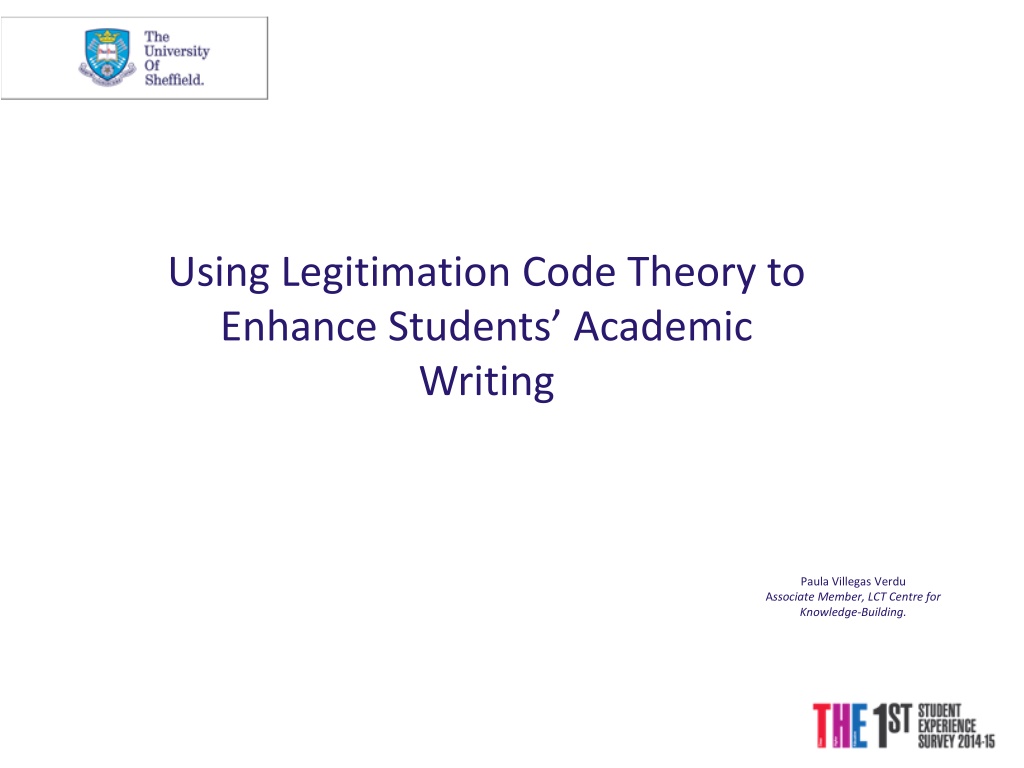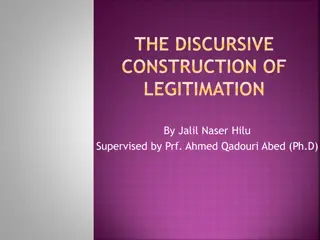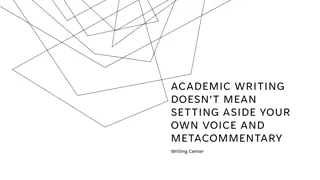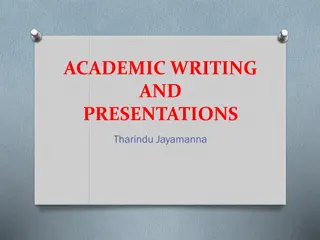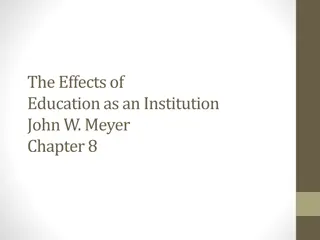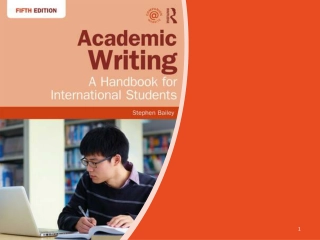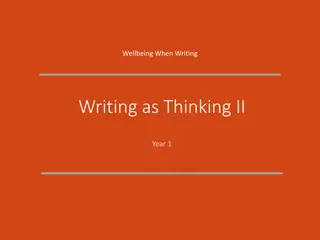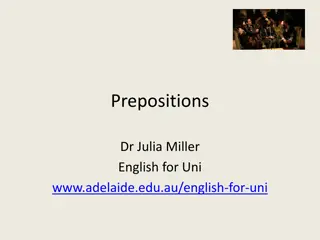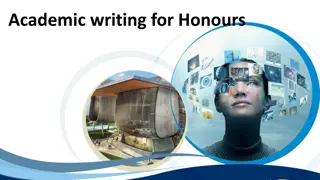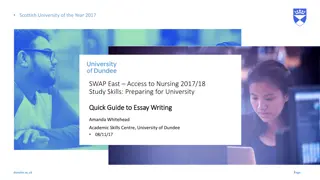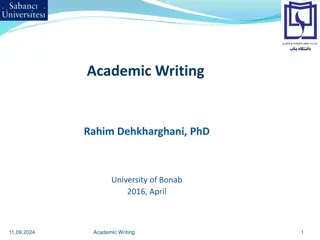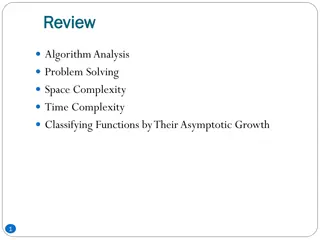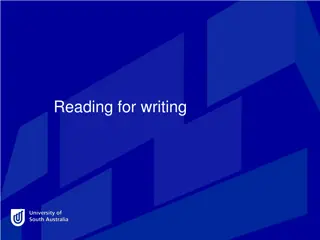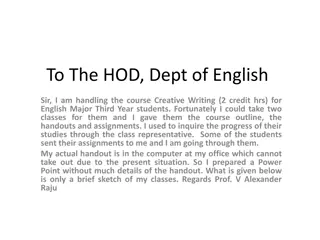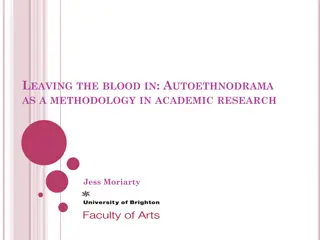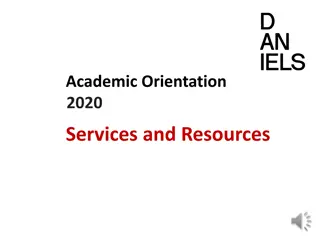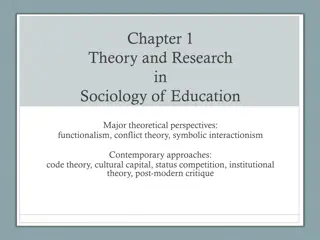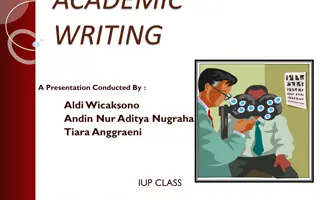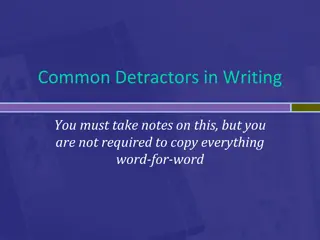Enhancing Academic Writing with Legitimation Code Theory
Explore how Legitimation Code Theory (LCT) can help identify and explain the expectations for good academic paragraphs. Delve into practical activities and discussions regarding academic writing standards and the use of LCT in guiding student output. Gain insights into the nuances of academic discourse and the application of LCT in academic contexts.
Download Presentation

Please find below an Image/Link to download the presentation.
The content on the website is provided AS IS for your information and personal use only. It may not be sold, licensed, or shared on other websites without obtaining consent from the author. Download presentation by click this link. If you encounter any issues during the download, it is possible that the publisher has removed the file from their server.
E N D
Presentation Transcript
Using Legitimation Code Theory to Enhance Students Academic Writing Paula Villegas Verdu Associate Member, LCT Centre for Knowledge-Building.
Overview What do we expect in a good academic paragraph? How can LCT help us identify what we want students to produce? How do we use LCT to explain what we want students to produce? - Practical Activities. Recap What is next?
What do you expect in a good academic paragraph? Durkheim (1933) suggests that deviance exists because actions from those outside the norm shock the collective conscience (p. 38). In the case of female bodybuilders, pursuing their sport is seen as challenging the social distinction between masculinity and femininity. It is taken as a blatant attempt to defy the traditional notion of the female body (Aitchison, 2006). Unfortunately, female bodybuilders are often met with disapproval. From stares from fellow gym users to insensitive comments, female bodybuilders suffer from forms of opposition. Linda agreed wholeheartedly when I brought this up. People talk about female athletes and they expect track stars and netballers, she said. Chare (2004) labels the resistance of female bodybuilders against this cultural norm as the radical politics of muscle . The female bodybuilder s physique strongly opposes the traditional female body and representation of femininity. Student A (revised) Brooke, (2017p.55-56 )
What do you expect in a good academic paragraph? Durkheim (1933) suggests that deviance exists because actions from those outside the norm shock the collective conscience (p. 38). In the case of female bodybuilders, pursuing their sport is seen as challenging the social distinction between masculinity and femininity. It is taken as a blatant attempt to defy the traditional notion of the female body (Aitchison, 2006). Unfortunately, female bodybuilders are often met with disapproval. From stares from fellow gym users to insensitive comments, female bodybuilders suffer from forms of opposition. Linda agreed wholeheartedly when I brought this up. People talk about female athletes and they expect track stars and netballers, she said. Chare (2004) labels the resistance of female bodybuilders against this cultural norm as the radical politics of muscle . The female bodybuilder s physique strongly opposes the traditional female body and representation of femininity. Student A (revised) Brooke, (2017p.55-56 )
What do you expect in a good academic paragraph? Durkheim (1933) suggests that deviance exists because actions from those outside the norm shock the collective conscience (p. 38). In the case of female bodybuilders, pursuing their sport is seen as challenging the social distinction between masculinity and femininity. It is taken as a blatant attempt to defy the traditional notion of the female body (Aitchison, 2006). Unfortunately, female bodybuilders are often met with disapproval. From stares from fellow gym users to insensitive comments, female bodybuilders suffer from forms of opposition. Linda agreed wholeheartedly when I brought this up. People talk about female athletes and they expect track stars and netballers, she said. Chare (2004) labels the resistance of female bodybuilders against this cultural norm as the radical politics of muscle . The female bodybuilder s physique strongly opposes the traditional female body and representation of femininity. Student A (revised) Brooke, (2017p.55-56 )
What do we expect in a good academic paragraph? This paragraph uses both the literature and specific examples from context to create a cohesive academic paragraph. As opposed to Paragraphs which engage with academic literature but fail to relate the quotes to the relevant context. (What is the point of all these quotes?) Paragraphs which explains the relevant context but fail to engage with the literature. The examples are too specific and anecdotal. (Can you back this up with evidence?)
Semantic Profiles Figure 1. Semantic Profiles (Maton, 2014 p.38). Line A-> Academic Literature Line B -> Specific Context Line C -> Specific Context + Academic Literature
How can LCT help us identify what we want students to produce? Semantic Gravity Degree of context-dependence of meaning, it can be stronger (+) or weaker (-) along a range of strengths weaker = less context-dependent stronger = more context-dependent Example one Revolution (SG-) / Industrial revolution (SG+) Example two Solution (SG-) / homogenous mixture of two or more substances
How can LCT help us identify what we want students to produce? Semantic Gravity strengthening semantic gravity e.g. moving down from abstract concept to concrete examples weakening semantic gravity e.g. moving up from concrete examples to more abstract ideas
How can LCT help us identify what we want students to produce? Semantic Gravity Degree of complexity in meaning , it can be stronger (+) along a range of strengths SD- weaker = less meaning is condensed stronger = more meaning is condensed SD+ Example Gold as the shiny metal used in jewellery / Au
How can LCT help us identify what we want students to produce? Semantic Density Degree of complexity in meaning weakening semantic density e.g. unpacking a dense concept by putting it into everyday language strengthening semantic density e.g. taking a lengthy description and packing it up into a symbol or technical term
How can LCT help us identify what we want students to produce? The Semantic Dimension Figure 4. The relationship between SG & SD (Maton, 2011 as cited in Blackie, 2014 p. 464)
The Semantic Dimension: Unpacking and Repacking Figure 2. Unpacking (Maton, 2014 p. 40) Figure 3.Repacking (Maton, 2014 p.41)
How do we use LCT to explain what we want? - Practical Activities Brooke (2017) designs an instructional model to facilitate gravity waving. Brooke (2017) reports positive results, although he acknowledges the complexity of LCT he argues that students engaged with it and gave a very good feedback overall.
How do we use LCT to explain what we want? - Practical Activities Ingold & O'Sullivan (2017) Example texts are given. Both ideas & language can be explored Students are given different semantic graphs and decide which one represent each paragraph. Cut out key noun groups from example paragraphs. Students place them on graph axes Students construct the waves Students write their own paragraph following the template Students cut up the key nouns/ NPs from their own paragraph and give them to another group who tries to place them in the graph axes
How do we use LCT to explain what we want? - Practical Activities Semantic Gravity What does it look like in my classroom? - Structure Examples/ Evidence Topic Sentence From stares from fellow gym users to insensitive comments, female bodybuilders suffer from forms of opposition. Linda agreed wholeheartedly when I brought this up. People talk about female athletes and they expect track stars and netballers, she said Durkheim (1933) suggests that deviance exists because actions from those outside the norm shock the collective conscience (p. 38). Evidence from the literature Concluding sentence Sentence In the case of female bodybuilders, pursuing their sport is seen as challenging the social distinction between masculinity and femininity. It is taken as a blatant attempt to defy the traditional notion of the female body (Aitchison, 2006). Chare (2004) labels the resistance of female bodybuilders against this cultural norm as the radical politics of muscle . The female bodybuilder s physique strongly opposes the traditional female body and representation of femininity.
How do we use LCT to explain what we want? - Practical Activities Semantic Gravity What does it look like in my classroom? Structure Academic Literature Academic Literature Example specific to your context Example specific to your context
How do we use LCT to explain what we want? - Practical Activities Semantic Gravity What does it look like in my classroom? - Blank model Examples/ Evidence Topic Sentence Concluding Sentence Evidence from the literature
How do we use LCT to explain what we want? - Practical Activities Semantic Density What does it look like in my classroom? Language Nominalization Recognizing Nominalization Regular but brief communication with the sales forces in the field is essential. It is essential to communicate regularly but briefly with the sales force in the field.
How do we use LCT to explain what we want? - Practical Activities - Semantic Density What does it look like in my classroom? Language Nominalization Practice -> What do you need to change? Researchers have to judge how valid and reliable the web sites are. Researchers have to judge the validity and reliability of the web sites. Researchers have to judge how valid and reliable the web sites are.
How do we use LCT to explain what we want? - Practical Activities - Semantic Density What does it look like in my classroom? Language Every day phrases in my essay Academic version It is essential to communicate regularly but briefly with the sales force in the field. Regular but brief communication with the sales forces in the field is essential.
How do we use LCT to explain what we want? - Practical Activities What does it look like in my classroom? Language A helping hand But how do I refer to my sources? -> Manchester Phrasebank.
How do we use LCT to explain what we want? - Practical Activities What does it look like in my classroom? Language A helping hand How do I know if my language is academic? expresso text analysis
What is next? LCT is becoming increasingly popular Active online community LCT webpage Roundtables Legitimation Code Theory Journal recently founded (Maton, 2017) It can be combined with other theories, methods or approaches (SFL)
Bibliography Brooke (2017) Using semantic waves to guide students throughout the research process: from adopting a stance to sound cohesive academic writing. Asian Journal of the Scholarship of Teaching and Learning. Vol 7 Issue 1. Gillet, A. 2015. Features of academic writing: complexity. [online] Available at: http://www.uefap.com/writing/feature/complex.htm#mod [Accessed 20 April 2015]. Ingold& O'Sullivan (2017) Riding the waves to academic success. English for academic purposes. Vol.26 Issue 2 Maton (2017) Personal Correspondence. Maton (2014) Knowledge and knowers: towards a realist sociology of education. Routledge, 2014, 244 pp, ISBN: 978-0-415-47999-8 (hbk) Maton, K. (2014) Building powerful knowledge: The significance of semantic waves, in Rata, E. & Barrett, B. (eds) Knowledge and the Future of the Curriculum: International studies in social realism, London: Palgrave Macmillan Maton, K. (2013) Making semantic waves: A key to cumulative knowledge-building, Linguistics and Education, 24(1): 8-22. To Discover And Understand. Queen Mary University of London. 2012. Nominalization. [online] Available at: http://aeo.sllf.qmul.ac.uk/Files/Nominalization/Nom%20LOC.html [Accessed 20 April 2015]. Paterson, K. 2013. Oxford Grammar for EAP. Oxford: Oxford University Press. p39. Sowton, C. 2012. 50 Steps to improving your academic writing. Reading: Garnet Publishing Ltd. p.101. Subject Centre for Languages, Linguistics and Area Studies Materials Bank. nd. Using noun phrases instead of clauses. [online] Available at: https://www.llas.ac.uk//materialsbank/mb063/eap/05/vs70402.htm [Accessed 23 April 2015]. Implementing the student-driven research project. Active Learning in Higher Education 11/1. pp 31 42. in Queen Mary University of London. 2012. Noun Phrases. [online] Available at: http://aeo.sllf.qmul.ac.uk/Files/NounPhrases/Noun%20Phrases.html [Accessed 20 April 2015]. Vandiver, D. M. & J. A. Walsh. 2010. Assessing autonomous learning in research methods courses:
